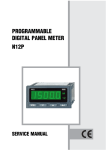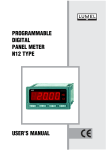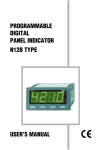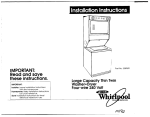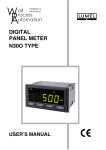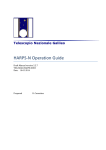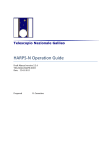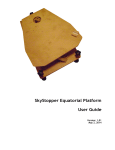Download USER`S MANUAL N11P TYPE
Transcript
PROGRAMMABLE DIGITAL PANEL METER N11P TYPE USERS MANUAL 1 2 PROGRAMMABLE DIGITAL PANEL METER N11P type USERS MANUAL CONTENTS 1. APPLICATION ..................................................................... 5 2. BASIC REQUIREMENTS, OPERATIONAL SAFETY ......... 7 3. FITTING ............................................................................... 9 4. CONNECTION .................................................................... 10 5. HANDLING ......................................................................... 10 6. PROGRAMMING ................................................................ 15 7. TECHNICAL DATA ............................................................. 25 8. BEFORE A FAILURE WILL BE DECLARED ...................... 33 9. PROGRAMMING EXAMPLES OF N11P METERS ........... 34 10. EXECUTION CODES ......................................................... 36 3 4 1. APPLICATION N11P programmable digital meters are destined to measure single-phase parameters: a.c. voltages and a.c. currents, active, reactive and apparent power, power factor cosj, ratio of the reactive power to the active power, phase angle j, frequences, active, reactive and apparent energy, 15 minutes active power, 10 minutes voltage, 10 seconds frequency. Additionally, the meter enables the indication of the current time. A 5 or 4-digit display field (14 or 20mm high digits) in red or green colour ensures a good readability at a long distance. They realized other additional functions as: signalling the set alarm value exceeding, signalling the measuring range exceeding, automatic set - up of the decimal point, programmable measurement repetition rate, programmable averaging type: arithmetic mean, steeping window, programming of the voltage and current ratio, programming of the alarm and analogue output with the reaction to an optional measured quantity, independently of currently displayed values, l storage of maximal and minimal values of all input quantities, l resetting of counters: active, reactive and apparent energy, l synchronization of 15 minutes power, 10 minutes voltage, l monitoring of set parameters values, l monitoring of all measuring quantities, l blocking of the parameter introduction by means of a password, l conversion of the measured quantity into any quantity on the base of an individual linear characteristic, l highlighting of any measuring quantity according to the order, l storage of counter states. l l l l l l l N11P digital panel meter enables the measurement of: l true rms voltage ............................................................. U sk = 1 n 2 ∑ ui n i =1 l 10 minutes mean voltage ............................................... U r = 1 10 ∑ U ski n i =1 l true rms current ............................................................... I sk = 1 n 2 ∑ ii n i =1 l active power ...................................................................... P = 1 n n ∑u i =1 i ⋅ ii 5 l mean active power (0 to 3600 sec., e.g. 15 minutes) ......... Psr = Ep = l active energy .................................................................... l reactive power ......................................................... 1 n ∑ aPi n i =1 S = U sk ⋅ I sk l apparent power .................................................................... ES = l apparent energy ................................................................ 1 n ∑ Pi n i =1 ( 1 n ∑ aSi n i =1 Q = sign S 2 − P 2 l reactive energy ................................................................ EQ = ) n 1 ∑ aQi n i =1 l active power factor ................................................................. cos ϕ = P S l ratio of the reactive power to active power ............................ tg ϕ = Q P l phase angle ............................................................ P ϕ = sign arc cos S l voltage frequency ....................................................................... l mean 10 seconds frequency ............................................. f r = f = 1 T 1 10 ∑ fi n i =1 External ratios of measuring current and voltage transformers are taken into consideration in measurement. The ratio is optionally programmed. With the meter we deliver: - a guarantee card - 2 holders to fix the meter into a panel - a plug with the screw connections or self-locking connections - a users manual - a set of stickers with units. When unpacking the meter, please check whether the type and execution code on the data plate correspond to the order. 6 2. BASIC REQUIREMENTS, SAFETY INFORMATION Symbols located in this service manual mean: ! ? WARNING! Warning of potential, hazardous situations. Especially important. One must acquaint with this before connecting the N11P programmable digital meter. The non-observance of notices marked by these symbols can occasion severe injuries of the personnel and the damage of the instrument. CAUTION! Designates a general useful note. If you observe it handling of the N11P programmable digital meteris made easier. One must take note of this when the instrument is working inconsistently to the expectations. Possible consequences if disregarded. In the security scope the N11P programmable digital metermeets the requirements of the EEC. Low-Voltage directive (EN 61010-1 issued by CENELEC). Remarks concerning the operator safety: 1. General l The N11P programmable digital meter is destined to be mounted on a panel. l Non-authorized removal of the required housing, inappropriate use, incorrect installation or operation creates the risk of injury to personnel or damage to equipment. For more detailed information please see the service manual. l All operations concerning transport, installation, and commissioning as well as maintenance must be carried out by qualified, skilled personnel and national regulations for the prevention of accidents must be observed. l According to this basic safety information, qualified, skilled personnel are persons who are familiar with the installation, assembly, commissioning, and operation of the product and who have qualifications necessary for their occupation. 2. Transport, storage Please observe the notes on transport, storage and appropriate handling. Observe the climatic conditions given in Technical Data. 7 3. Installation l The N11P programmable digital meter must be installed according to the regulation and instructions given in this service manual. l Ensure proper handling and avoid mechanical stress. l Do not bend any components and do not change any insulation distances. l Do not touch any electronic components and contacts. l Instruments may contain electrostatically sensitive components, which can easily be damaged by inappropriate handling. l Do not damage or destroy any electrical components since this might endanger your health! 4. Electrical connection l Before switching the N11P programmable digital meter on, one must check the correctness of connection to the network. l In case of the protection terminal connection with a separate lead one l l l l must remember to connect it before the connection of the instrument to the mains. When working on live instruments, the applicable national regulations for the prevention of accidents must be observed. The electrical installation must be carried out according to the appropriate regulations (cable cross-sections, fuses, PE connection). Additional information can be obtained from the service manual. The documentation contains information about installation in compliance with EMC (shielding, grounding, filters and cables). These notes must be observed for all CE-marked products. The manufacturer of the measuring system or installed devices is responsible for the compliance with the required limit values demanded by the EMC legislation. 5. Operation Measuring systems including N11P programmable digital meter must be equipped with protection devices according to the corresponding standard and regulations for prevention of accidents. After the instrument has been disconnected from the supply voltage, live components and power connections must not be touched immediately because capacitors can be charged. The housing and the door must be closed during operation. 8 6. Maintenance and servicing Please observe the manufacturers documentation. Read all product-specific safety and application notes in this service manual: Before taking the N11P programmable digital meter housing out, one must turn the supply off. The removal of the instrument housing during the guarantee contract period may cause its cancellation. 3. FITTING Prepare a (92 +0.6 x 45 +0.6) mm hole in the panel. The thicknes of the material from which the panel is made can not exceed 15mm. One should introduce the meter from the front of the panel with disconnected supply circuit. After introducing the meter, fasten it by means of holders. max 93 kW Fig. 1. Overall dimensions 9 4. CONNECTION At the rear side of the meter there is a terminal strip seat. A connector with screw terminals or a self-locking connector is added to the meter depending on the meter type chosed in the ordering code. The fig.2 shows the connection of external signals. The description of the connector is also printed on the meter housing. 3 4 5 L1 5A COM 1A 2 or L1 N S1 S2 P1 P2 a A 9 10 11 12 13 14 15 6 L2 or N 100 V or 400 V Alarm 1 Alarm 2 L N Supply b B Fig.2 N11P connection way In case of a meter working in an environment of high perturbances one should use external filters. As a feeder cable one must use a two-wire cable and choose the lead crosssection such that in case of a short-circuit from the device side, the protection of the cable was ensured by means of the electric installation fuse. Requirements related to the feeder cable are regulated by the EN 61010 - 1 p.6.10. standard. 5. HANDLING After switching the meter on, its type and next, the program version are displayed. After ca 10 sec., the meter transists automatically into the measuring mode and the input signal value is displayed. The meter blanks automatically insignificant zeros. Values of the decimal point and the multiplier in the measurement of voltage, current or power are automatically set up taking into consideration assigned ratios. 10 The exceeding of the alarm threshold is signalled by means of alarm diodes 1 and 2. The basic unit of the measured value is automatically highlighted by the meter 1). a) 5-digit execution kW Unit Alarm diodes Erasing key Key to decrease the value Key to increase the value Acceptance key b) 4-digit execution Alarm diodes Erasing key Key to decrease the value Key to increase the value Acceptance key Fig.3 Description of the meter faceplate 1) No exists in the 4-digit (20mm) execution 11 Key functions: - acceptance key l entry into the programming mode (hold down during ca 3 seconds), l moving through the menu - choice of the level, l moving through the monitoring menu of measured values - selection of the next value, l entry into the change mode of the parameter value, l acceptation of the changed parameter value - key to increase the value l display of the maximal value, l display of the maximal value - monitoring menu of measured parameters, l entry to the parameter group level, l moving through the chosen level, l change of the chosen parameter value - increase of the value, l successive parameter in the monitoring mode. - key to decrease the value l display of the minimal value, l display of the minimal value - monitoring menu of measured parameters, l entry to the parameter group level, l moving through the chosen level, l change of the chosen parameter value - decrease of the value, l successive parameter in the monitoring mode. - resignation key l entry to the menu of parameter monitoring (hold down during ca 3 seconds), l exit from the monitoring menu of meter parameters and measured values, l resignation of the parameter change, l absolute exit from the programming mode The pressure of the key combination and holding down during ca 3 sec. causes the erasing of alarm signalling. This operation exclusively acts when the support function is switched on. The pressure of the minimal values. 12 key combination causes the erasing of all The pressure of the key combination causes the erasing of all maximal values. The pressure and holding down of the key during ca 3 sec. causes the entry into the programming matrix. The programming matrix is secured by the safeguard code. The pressure and holding down of the key during ca 3 sec. causes the entry into the monitoring menu. One must move through the monitoring menu by means of and keys. In this menu, all programmable meter parameters, except service parameters, are only accessible to the read-out. The exit from the monitoring menu takes place by means of the key. On the monitoring menu, parameter symbols are alternately displayed together with their values. The fig. 4. shows the operation algorithm of the meter. The pressure and holding down of and keys during ca 3 sec. causes the entry to the monitoring menu of measured value. One must move through the monitoring menu by means of , and keys. key causes the display of the successive symbol The pressure of the of the measured value alternately with the value and the multiplier of this value in one of the shape 10E0, 10E3, 10E6, 10E9. The pressure of the key causes the display of the minimal value of the currently displayed value, whereas the pressure of the key causes the display of the maximal value of the currently displayed value. The exit from the menu is proceeded by means of the key. 13 14 Display of max. value Monitoring menu of meter parameters Monitoring menu of measured values 3 sec. Display of min. value 3 sec. Incorrect Display of Err inscription Erasing of all min. value Fig. 4. Operation algorithm of the N11P meter Programming matrix Correct Password checking Password introduction 3 sec. MEASUREMENT Erasing of all max. value 3 sec. Erasing of alarm signalling The appearance of the following symbols on the digital displays means: - Incorrectly introduced security code. ? - Overrunning of the upper measuring range - Overrunning of the lower measuring range 6. PROGRAMMING The key pressure and its holding down during ca 3 seconds causes the display of the security code symbol SEC alternately with the 0 value set up by the manufacturer. The writing of the correct code causes the entry into the programming matrix. The transition matrix into the programming mode is shown key, whereas the on the fig. 5. We choose the level by means of the entry and moving through parameters of the chosen level is carried out by means of the and keys. Parameter symbols are displayed alternately with their actual values. In order to change the value, one must use the key. To resign of the parameter change one must press the key. To exit from the chosen level one must select the symbol - - - and press the key. In order to exit from the programming matrix into measurement, one must press the key. The inscription HEY occurs and after ca 5 sec., the meter will automatically enter into the measurement of the input quantity. Way of changing the value of the chosen parameter In order to increase the value of the chosen parameter one must press the key. A single pressure of this key causes a value increase of 1. The key causes a continuous increase of the value hold of the pressed down to the display of the 0 value. The jump to the next digit follows after this value. 15 16 JEd Unit highlight Hour Hour setting SEr SEt SEC tSt Service Writing of Password Display standard introd. test parameters (2) dLY2 Alarm delay dLY1 tYP2 Alarm type tYP1 PrL2 PrH2 ALr2 P_A2 Upper Alarm 2 Kind of input Lower threshold threshold quantity for alarm 2 PrH1 Alarm delay PrL1 P_A1 CEnP resetting of active energy counter Signal support LEd2 Signal support LEd1 CEnq resetting of reactive energy counter --- --- CPau synchr. of 15 min power (1) H1 (1) Y1 Cuau synchr. of --10 min voltage Fig. 5. Transition matrix into the programming mode CEnS resetting of appar. energy counter trU UAL trI Aur Ind Voltage Number Linear Current Kind of transformer transformer averaging of mea- charact. ratio surem. ratio Alarm type ALr1 RAnU RAnI Voltage Current input input range range Upper Alarm 1 Kind of input Lower threshold threshold quantity for alarm 1 SYn Type of input synchronization tYP Type of displayed quantity (1) Exists only when the individual characteristic is attached (Ind =0) (2) Exists only in executions with 5 displays. 4 3 2 Pos. InP no. Input param. 1 (1) H2 (1) Y2 d_P (1) Decimal - - point The further change is similar. In any moment, the key release causes a jump to the first digit. It is similarly in case of the value decrease. A single pressure of the key causes a value decrease of one. The hold of the key pressure down causes a continuous decrease of the value down to the display of the 0 value. The jump to the next digit follows after this value. The further change is similar. The key release in any moment causes a jump on the first digit. In order to accept the set up parameter one must press the key. Then, the writing of the parameter and display of its symbol follows alternately with the new value. The pressure of the key during the change of the parameter will cause the resignation of the writing. Table 1 Parameter symbol tYP Range of changes Description Selection of the measured U value. I FrEq P q S PF tF FI EnP Enq EnS P_Au U_Au F_Au Hour SYn - rms voltage - rms current - frequency - active power - reactive power - apparent power - power factor, cosj - ratio of reactive power to active power, tgj - angle phase, j - active energy - reactive energy - apparent energy - 15 minutes mean active power - 10 minutes mean voltage - 10 seconds mean frequency - current time Selection of the synchroniza- nAP - voltage synchronization tion of the input signal PrAd - current synchronization 17 RanU Selection of voltage range 100U - 100 V range 400U - 400 V range RanI Selection of current range 1A - 1 A range 5A - 5 A range trU Selection of voltage ratio In 4-digit execution: 0...9999 In 5-digit execution: 0...99999 trI Selection of current ratio In 4-digit execution: 0...9999 In 5-digit execution: 0...99999 Aur Selection of the averaging Cnt - Arythmetic mean mode CntS - Stepping window UAL Number of avaraged measurements. The time of a single measurement is 500ms. The measurement value is refreshing every UAL on the diplay - 500ms . In 4-digit execution: 0...9999 Switching off or on of the users individual linear characteristic On - Characteristic switched on Parameters of the individual characteristic. On the base of co-ordinates of two points given by the user, the meter assigns coefficients of the individual characteristic a and b Y = aH + b. In 4-digit execution: -1999...9999 Ind H1,Y1, H2,Y2 H1 and H2 - measured value Y1 and Y2 - expected value on the display 18 In 5-digit execution: 0...99999 The writing of the 0 causes the measurement switching off and the blanking of displays. OFF - Characteristic switched off In 5-digit execution: -19999...99999 d_P Setting of the decimal point. This setting acts when the individual characteristic is switched on. When the characteristic is switched off the decimal point is set automatically. Setting possibilities in the 4-digit execution: 0000 000,0 00,00 0,000 P_A2 Kind of input quantity type at which the alarm is to react U I FrEq P q S PF tF PrL1 Alarm lower threshold In 4-digit execution: -1999...9999 P_A1 PrL2 PrH1 PrH2 In the 5-digit execution: 00000 0000,0 000,00 00,000 0,0000 - rms voltage - rms current - frequency - active power - reactive power - apparent power - power factor, cosj - ratio of reactive power to active power, tgj FI - angle phase, j EnP - active energy Enq - reactive energy EnS - apparent energy P_Au - 15 minutes mean active power U_Au - 10 minutes mean voltage F_Au - 10 seconds mean frequency In 5-digit execution: -19999...99999 Alarm higher threshold In 4-digit execution: -1999...9999 In 5-digit execution: -19999...99999 19 tYP1 tYP2 dLY1 dLY2 LEd1 LEd2 20 Alarm type. The fig. 6. shows the graphical illustration of alarm types. nor - normal On - switched on OFF - switched off H_On - manually switched on, till the time of the alarm type change, the alarm output is switched on for good. H_OF - manually switched off, till the time of the alarm type change, the alarm output is switched off for good. Delay of alarm operation. The parameter is defined in seconds, that means that one must give after how many seconds the alarm operation follows. The alarm switching off follows without delay. The parameter takes in account the number of averaged measurements UAL, i.e. the whole averaging cycle is treated as a single measurement. In 4-digit execution: 0...9999 In 5-digit execution: 0...99999 The introduction of 0 causes the operation at the moment of alarm appearance. Support of the alarm On - support switched on signalling. In the situation OFF - support switched off when the function of support is switched on after the withdrawal of the alarm state, the signalling diode is not blank. It signals the alarm state till the moment of its blanking by means of the combination of and keys. This function only and exclusively concerns the alarm signalling and then the relay contacts will act without support, according the chosen alarm type. SEt Writing down of manufacturers settings. Parameter values set up by the manufacturer are shown in the table 2. A pressure of the key causes the writing down of standard parameters into the meter. The execution of this operation is signalled by the inscription End. SEC Introduction of a new password. In 4-digit execution: -1999...9999 In 5-digit execution: -19999...99999 tSt Hour Display test. The test consists The pressure of the key on the consecutive switching causes the test switching on. of digital display segments on. The key ends the test. Alarm diodes and highlighted diodes of the unit should be lightened. Setup of the current time. 0,00...23,59 The introduction of an incorrect hour will cause its writing into the memory, but after the exit from the matrix the meter will make the correction of the error, i.e. the introduction of the 0.70 hour will cause that the meter will treat that as minutes and set up 1.10. JEd Unit highlighting switching on. On - highlighting switched on OFF - highlighting switched off CEnP Resetting of the active power The pressure of the key counter. will cause the resetting of the active power counter. CEnq Resetting of the reactive power counter. The pressure of the key will cause the resetting of the reactive power counter. CEnS Resetting of the apparent power counter. The pressure of the key will cause the resetting of the apparent power counter. 21 CPAu Synchronisation of the 15 minutes mean active power. key The pressure of the will cause the measurement start of the 15 minutes mean active power. CUAu Synchronisation of the 10 minutes mean voltage. The pressure of the key will cause the measurement start of the 10 minutes mean voltage. Exit from the parameter group of the chosen level. The pressure of the key causes the exit from the parameter group of the chosen level. ----- a) nor Contact state 1 0 Relay switched on Relay switched off PrL PrH Measured quantity PrH > PrL b) nor Contact state 1 0 Relay switched off Relay switched on PrH PrL PrH < PrL 22 Measured quantity c) OFF Contact state 1 Relay switched on 0 Relay switched on Relay switched off PrL PrH Measured quantity d) On Contact state 1 0 Relay switched off Relay switched on PrL PrH Relay switched off Measured quantity Fig. 6. Alarm type: a) and b) normal, c) switched off, d) switched on ? CAUTION l In case of On and OFF alarm types, the writing down of PrL > PrH will cause an automatic transcription of the value from the threshold PrL into PrH and from the threshold PrH into PrL. The alarm type will not change. l In case of a measuring range overrunning the relay reaction is concordant with written down PrL, PrH and tYP parameters. In spite of displaying the overrunning, the meter will carry out the measurement as before. l In case of an individual characteristic switching on (Ind = On) the measurement result is transformed linearly in accordance with introduced H1, Y1, H2, Y2 parameters. The linear characteristic does not operate in case of selection as an input type of the current time. l The meter currently checks up the value of the actually introduced parameter. In case when the introduced value overruns the upper range of changes given in the table 1, the meter will automatically carry out the change into the minimal value. Similarly, in case when the introduced value overruns the lower range of changes given in the table 1, the meter will automatically carry out the change into the maximal value. 23 Standard parameters of the meter Table 2 Parameter symbol Level in the matrix Standard value tYP 1 P SYn 1 nAP RAnU 1 400U RAnI 1 5A trU 1 1 trI 1 1 Aur 1 Cnt UAL 1 2 Ind 1 OFF H1,Y1,H2,Y2 1 0 d_P 1 1 P_A1 2 U P_A2 3 I PrL1 2 0 PrL2 3 400.0 lub 400.00 PrH1 2 0.000 lub 00.000 PrH2 3 5.000 lub 5.0000 tYP1, tYP2 2,3 OFF dLY1, dLY2 2,3 0 LEd1, LEd2 2,3 OFF SEC 5 0 Hour 5 0.00 JEd 5 On CAUTION: If the meter works only as an ammeter one should chose the parameter SYn, value PrAd, in the menu. 24 ? 7. TECHNICAL DATA Panel meter dimensions Protection index ensured by the housing Protection index ensured from the terminal side Rated operating conditions: supply voltage depended on the execution code supply voltage frequency ambient temperature air relative humidity 96 ´ 48 ´ 84 mm IP 50 IP 20 85...230...253 V a.c. d.c. 20...24...40 V a.c. d.c. 40...50...440 Hz 0...23...50°C < 75% (water vapour condensation inadmissible) Power consumption max 5 VA Storage temperature - 20... + 85°C Display field N11P4 N11P5 four 7-segment LED displays and two alarm diodes five 7-segment LED displays two alarm diodes, and two diodes to the unit highlighting Indication range of the digital display: N11P4 N11P5 -1999...9999 -19999...99999 Servicing four keys: Relay outputs: programmable alarm thresholds, three types of alarms (see chapter 6), hysteresis defined by means of the lower and upper alarm thresholds, signalling of alarm action by means of diodes, programmable delay of the alarm operation, two relay outputs, 25 voltageless - make contacts - maximal load capacity: voltage: 250 V a.c., 150 V d.c. current: 5 A, 30 V d.c., 250 V a.c. resistance load: 1250 VA, 150 W Fastness against supply decays: acc. EN 50082-2, all programming parameters storage, counter state chosen on a display storage, in any other case the active counter energy is storaged. Electromagnetic compatibility: immunity acc. EN 50082-2 emission acc. EN 50081-2 Safety requirements: according EN 61010-1 standard: installation category III level of pollution 2 maximal voltage in relation to the earth 600 V 26 ! Parameters of the N11P meter: prolonged overrunning of the upper range: 20% Kind of input Indication range 5 digits 4 digits Basic error Rms voltage 1...100.0 1...100.0 ± (0.1% i.v. + 0.2% u.l.) Rms voltage 4...400.0 4...400.0 ± (0.1% i.v. + 0.2% u.l.) Rms current 0.01...1.000 0.01...1.000 ± (0.1% i.v. + 0.2% u.l.) Rms current 0.05...5.000 0.05...5.000 ± (0.1% i.v. + 0.2% u.l.) Frequency 10.00...100.00 10.00...99.99 ± (0.1% i.v. + 0.1% u.l.) Active power -19999...19999* -1999...1999* ± (0.1% i.v. + 0.5% u.l.) Reactive power -19999...19999* -1999...1999* ± (0.1% i.v. + 0.5% u.l.) Apparent power 0...19999* 0...1999* ± (0.1% i.v. + 0.5% u.l.) cosj -1.000...1.000 -1.000...1.000 ± (0.1% i.v. + 1% u.l.)3) tgj -100.0...100.0 -100.0...100.0 ± (0.1% i.v. + 1% u.l.)3) j 0...359.9 0...359.9 ± (0.1% i.v. + 1% u.l.)3) Active energy -19999...99999* -1999...9999* ± (0.1% i.v. + 0.5% u.l.) Reactive energy -19999...99999* -1999...9999* ± (0.1% i.v. + 0.5% u.l.) Apparent energy 0...19999* 0...9999* ± (0.1% i.v. + 0.5% u.l.) 15 minutes active power -19999...19999* -1999...1999* ± (0.1% i.v. + 0.5% u.l.) 10 minutes voltage 1...100.0 1...100.0 ± (0.1% i.v. + 0.2% u.l.) 10 minutes voltage 4...400.0 4...400.0 ± (0.1% i.v. + 0.2% u.l.) 10 seconds frequency 10.00...100.00 10.00...99.99 ± (0.1% i.v. + 0.1% u.l.) Current time 0.00...23.59 0.00...23.59 1 sekunda/dobê * The range of the displayed value is equal to the transformation ratio product, maximal voltage rate, maximal current rate (Tru · Tri · Umax · Imax) 2) 3) i.v. - indicated value u.l. - upper limit of the measuring sub-range error in a range 10...120% of the I, U range 27 Measurement of the true rms a.c. voltage The voltage value is calculated according the formula: U sk = trU • 1 n 2 ∑ ui n i =1 trU - transformation ratio of voltage transformer (measuring transformer) n - number of samples in the period or in the multiple of the measured voltage u - instantaneous voltage value Basic error in reference conditions: ±(0.1% i.v. + 0.2% u.l.) Calculation of the mean value in the walking period of time: U srsk = n Usk Usrsk 1 n ∑ U SK1 n i =1 - averaging time in seconds - true rms value in the voltage period mean value changing in the time of the rms voltage value Basic error: ±(0.1% i.v. + 0.2% u.l.) Calculation of the 10 minutes voltage U r = Basic error: ±(0.1% i.v. + 0.2% u.l.) 28 1 10 ∑ U ski n i =1 Measurement of the true rms a.c. current The value of the current is calculated according the formula I sk = trI • trI n i 1 n 2 ∑ ii n i =1 - ratio of the current transformer - number of samples in the period or in the multiple of the measured current - actual value of the current Basic error in reference conditions: ±(0.1% i.v. + 0.2% u.l.) Calculation of the mean value in the walking period of time: I srsk = n Isk Isrsk 1 n ∑ I SK n i =1 1 - averaging time in seconds - true rms value in the voltage period - mean value changing in the time of the rms current value Basic error: ±(0.1% i.v. + 0.2% u.l.) Measurement of the a.c. active power The active power of the distorted current is calculated according the formula: P = trU • trI • trU trI n u i 1 n ∑ ui ⋅ ii n i =1 - ratio of the voltage transformer - ratio of the current transformer - number of samples in the period or in the multiple of the measured current - actual value of voltage - actual value of current 29 Basic error in reference conditions: ±(0.1% i.v. + 0.5% u.l.) Calculation of the mean value in the walking period of time: Psr = n Pi Psr 1 n ∑ Pi n i =1 - averaging time in seconds - value of the active power in the period of the measured signal - mean value changing in the time of the active power value Basic error: ±(0.1% i.v. + 0.5% u.l.) Calculation of the active power energy Ep = 1 n ∑ aPi n i =1 Basic error: ±(0.1% i.v. + 0.5% u.l.) Measurement of the a.c. apparent power The apparent power is calculated according the formula: S = trU • trI • U SK • I SK trU trI Usk Isk - ratio of the voltage transformer ratio of the current transformer real rms value of the voltage real rms value of the current Basic error in reference conditions: ±(0.1% i.v. + 0.5% u.l.) Counting of the apparent power energy: ES = Basic error: ±(0.1% i.v. + 0.5% u.l.) 30 1 n ∑ aSi n i =1 Measurement of a.c. reactive power The reactive power is calculated according the formula: ( Q = trU • trI • sign S 2 − P 2 trU trI S P - ) ratio of the voltage transformer ratio of the current transformer apparent power active power Basic error in reference conditions: ±(0.1% i.v. + 0.5% u.l.) Counting of the reactive power energy: EQ = 1 n ∑ aQi n i =1 Basic error: ±(0.1% i.v. + 0.5% u.l.) Measurement of the a.c. power factor - cosj The power factor is calculated according the formula: cos ϕ = P S P S - active power - apparent power Basic error in reference conditions: ±(0.1% i.v. + 1% u.l.) in the 10...120% current and voltage range 31 Measurement of the ration of the reactive power to the active power - tgj The ratio of the reactive power to the active power is calculated according the formula: tg ϕ = Q P - reactive power - active power Q P Basic error in reference conditions: ±(0.1% i.v. + 1% u.l.) in the 10...120% current and voltage range Measurement of the a.c. voltage frequency The frequency of the voltage is calculated according the formula: f = T f 1 T - period of a.c. voltage - frequency (current value of one period) Basic error in reference conditions: ±(0.1% i.v. + 0.1% u.l.) Calculation of the 10 seconds frequency: f r = n fi fr 1 n ∑ fi n i =1 - averaging time in seconds - frequency value in the period of the measured signal - mean value changing in the time of the frequency value Basic error: ±(0.1% i.v. + 0.1% u.l.) Preheating time Weight Minimal measurement time 32 15 minutes 0,2 kg 500 ms 8. BEFORE A FAILURE WILL BE DECLARED SYMPTOMS ? PROCEDURE 1. The meter does not operate Check the connection of the feeder cable 2. Only the diodes are lighting Number of measurements = 0 has been introduced. The meter operates in the SLEEP mode. The display is blanked. 3. Only the horizontal dashes are displayed Check the correctness of the input signal connection. See in the service manual. 4. Only the inscription noC is displayed The meter is discalibrated. Contact the nearest authorised service workshop. 5. Lack of possibility to enter into the programming mode. The inscription ErrC is displayed. The programming mode is protected by the password. If the user forgets which password has been introduced one must contact the nearest authorised service workshop. 6. Lack of certainty if all display segments are efficient Enter into the service mode and switch the display test on. Simultaneously the same segments should be lighted on all displays. The state with blanked displays does never occur. Otherwise, submit the defect to the nearest authorised service workshop. 7. During operations in the programming mode, parameter values inconsistent with the range of changes given in the table 1 appear on the display Enter into the service mode and accept the SEt parameter. The meter will introduce values in accordance with the table 2. 8. A result inconsistent with our expectations appears on the display. Check if the individual characteristic is not switched on. In case of necessity enter into the service mode and accept the SEt parameter. The meter will introduce parameters in accordance with the table 2. 9. H1, Y1, H2, Y2, d_P parameter symbols are not displayed in the programming mode In case of switched individual characteristic off, mentioned symbols are omitted. 10. Despite of the alarm threshold exceeding neither the alarm relay nor the signalling diode is switched on. Check the introduced delay of the alarm operations into the meter. If need be, correct the dLY Parameter. 33 11. Despite of the relay switching off, the alarm diode does not go out. Check if the alarm signalling support is not switched on. LEd parameter. In case of need, switch it off. 12. When the parameter of the alarm signalling support is switched on, lack of possibility to erase the signalling diode by means of the key combination. (Fig.4). The alarm still lasts. The erased diode is immediately re-lighted. 13. Despite the fact that the alarm still remains, the signalling diode does not light up. Check if a delay of the alarm operation has not been introduced. dLY parameter. 14. Instead to display the measurement result, the meter displays the parameter symbol alternately with its value despite we were not entered into the programming mode. The meter works in the monitoring mode. 15. A delay of the alarm operation has been introduced, e.g. 30 measurements, however after this time the alarm has not operate. The lasting alarm state was shorter than the programmed, e.g. during the lasting time of the alarm the state of alarm withdrawal has occurred. In that case the meter begins counting the measurements from the beginning 9. PROGRAMMING EXAMPLES OF N11P METERS Example 1 - Programming of an individual characteristic. If we want to programme so that to the value 0.0 V will correspond the value 0 on the display, whereas to the value 400.0 V will correspond the value 10000, one must: l choose as the type of the input quantity, the measurement of the voltage U, l chose the Ind parameter, and switch the individual characteristic on, l chose the parameter H1 and introduce the value 0.0, l pass on the Y1 parameter and introduce the value 0, l pass on the H2 parameter and introduce the value 400.0, l pass on the Y2 parameter and introduce the value 10000, l pass on the d_P parameter and set the point on 00000. 34 Example 2 - Programming of an inverse individual characteristic. If we want to programme so that to the value 5.000 A will correspond the value 0.00 on the display, whereas to the value 0.000 A will correspond the value 100.00, one must: l choose as the type of the input quantity the measurement of the current I, l choose the Ind parameter and switch the individual characteristic on, l choose the H1 parameter and introduce the value 0.000, l pass on the Y1 parameter and introduce the value 100.00, l pass on the H2 parameter and introduce the value 5.000, l pass on the Y2 parameter and introduce the value 0.00, l pass on the d_P parameter and set the decimal point on the position 000.00. Example 3 - Programming of the alarm with hysteresis If we want to programme the alarm 1 operation so that the alarm will be switched on at the value 400.0 V, whereas switched off at the value 100.0 V, and the alarm 2 so that at the value 5.000 A the alarm will be switched off and switched on at the value 1.000 A, one must: l enter into the programming mode and choose the level with the ALr1 symbol, l pass on the P_A1 parameter and set U, l pass on the PrL1 parameter and introduce the value 100.0, l pass on the PrH1 parameter and introduce the value 400.0 l pass on the tYP1 parameter and choose the function designed as nor, l exit from the ALr1 level and pass on the ALr2 level, l pass on the P_A2 parameter and introduce I, l choose the PrL2 parameter and introduce the value 5.000, l pass on the PrH2 parameter and introduce the value 1.000, l pass on the tYP2 parameter and choose the function nor. Example 4 - Programming of an alarm operating in the given interval with delay. If we want that the alarm 1 will be switched on in the interval from 100.0 V up to 300.0 V and operated only after 10 sec, one must: l enter into the programming mode and choose the ALr1 level, l pass on the P_A1 parameter and set U, l pass on the PrL1 parameter and introduce the value 100.0, l pass on the PrH1 parameter and introduce the value 300.0, 35 l pass on the tYP1 parameter and choose the On function, l pass on the dLY1 parameter and set 10 if UAL=1.0, in the contrary dLY = 10/UAL, l exit from the programming mode. In case of the alarm state duration for a time longer than 10 sec., the meter will switch the alarm relay on and the alarm diode will be lighted. EXECUTION CODES X Inputs: temperature, programmable input 1 V d.c., 10 V d.c., 20 mA d.c, 200 mA. 600 V d.c. , 1 A d.c. , 5 A d.c. revolutions, frequency, pulses, period singla-phase network parameters indicator for synoptic panels on order T S H O P B X Number of display: 4 x 20 mm high digits 5 x 14 mm high digits + unit Display colour: red green Supply voltage: 230 V a.c. d.c. 24 V a.c. d.c. Kind of terminals: socked-plug with screw connections socked-plug with self-locking connections Execution: standard execution custom-made execution Acceptance tests: without a guality inspection certificate with a guality inspection certificate acc. customers agreement *) - Introduce the unit symbol. 36 X X X X XX X XXX Unit field *) N11P METER 4 5 0 1 1 2 0 1 00 XX 0 1 X Order example: N11P 5 0 1 0 00 1 kW means: a N11P digital meter of single-phase network parameters, with 5 displays in red colour, voltage supply: 230 V a.c., d.c., kind of terminal: socket-plug with screw connection, standard execution, with a quality inspection certificate, with the highlighted kW unit. In case of a custom-made execution or need of more detailed technical information please contact our Export Department. In case of any meter failure one must contact the nearest authorized service workshop. The Manufacturer policy is one of continuous improvement and we reserve the right to make changes in design and specification of any products as engineering advances or necessity requires and revise the above specification without notice. 37 38 39 .A>HK=HO #








































